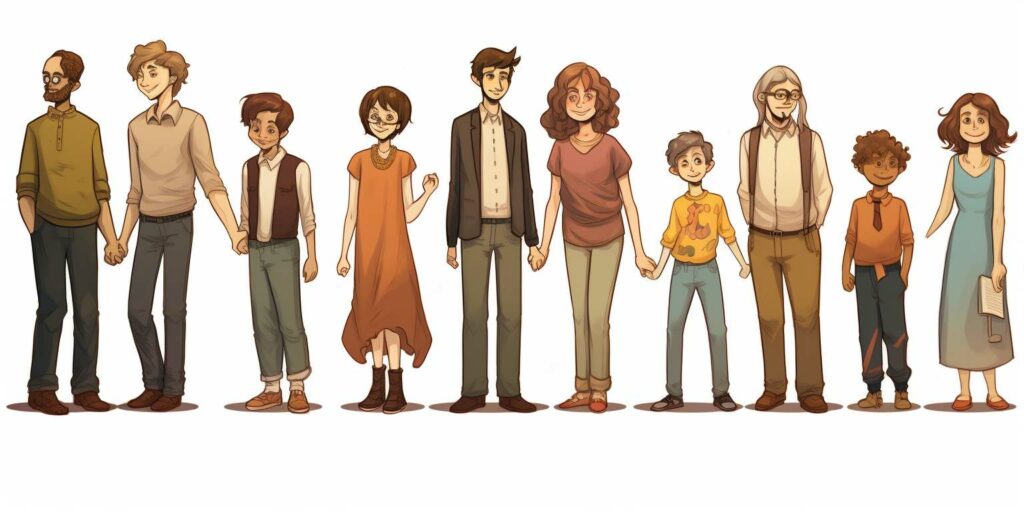In an increasingly interconnected world, understanding people – their motivations, behaviors, and relationships – is more important than ever. But to truly comprehend the nuances of human interaction, one must first turn to the root of it all: the family. The concept of family dynamics is a crucial foundation in the discourse of human behavior and social relationships. It sheds light on the various roles, relationships, and interactions within a family unit, acting as a mirror of societal norms, cultural contexts, and personal identities.
Family dynamics refer to the patterns of interactions among relatives, the structural organization of families, and the forces that shape these interactions and structures. It encompasses everything from communication styles and patterns, roles played by each member, power structures, to the emotional environment within the family. Understanding these dynamics can offer profound insights into an individual’s behavioral patterns, emotional health, and even future relationships.
However, the term ‘family’ itself isn’t as clear-cut as it seems. With cultural shifts, evolving societal norms, and increasing globalization, the concept of family has undergone significant transformation. Today, families come in all shapes and sizes, each with its unique set of dynamics. It’s important to recognize that there’s no ‘standard’ or ‘normal’ family structure, but rather a wide array of family types, each with its unique characteristics and dynamics.
In this piece, we will delve into six broad categories of family types, aiming to unravel their distinctive dynamics. From nuclear families and single-parent families to extended families, blended families, childless families, and same-sex families, each presents a unique framework that impacts the growth, development, and interaction patterns of its members.
By dissecting these diverse family structures, we can gain a richer understanding of the societal fabric, enabling us to foster healthier interactions and relationships within our own families and communities. This understanding could also inform social policies, mental health practices, educational strategies, and more, ensuring they align with the diverse realities of family life in the 21st century.
As we navigate through this exploration of family dynamics, it’s crucial to remember that every family, irrespective of its structure, carries the potential to provide a nurturing, supportive environment that fosters growth and development. With that in mind, let’s embark on this enlightening journey to uncover the intricacies of family dynamics across various family types.
Traditional Family
Traditionally, a family unit was often perceived as a couple and their children, commonly referred to as the nuclear or traditional family. Although society has evolved beyond this concept to embrace a diversity of family structures, the traditional family unit still forms a significant proportion and remains an influential archetype.
Within a traditional family structure, the dynamics are typically characterized by clear roles and responsibilities, dictated by long-standing societal norms and expectations. The members interact, communicate, and function in a manner that upholds these roles, contributing to the overall functioning of the family unit.
Role of Gender Norms in Traditional Families
One of the key pillars that influence traditional family dynamics is gender norms. In many traditional families, these norms define the responsibilities and roles of each member. Typically, the father is seen as the primary breadwinner, a protector providing financial stability, while the mother often undertakes the role of a homemaker, responsible for nurturing and maintaining the household.
However, as societies progress, these stereotypical gender roles are continually being challenged and redefined. It’s important to note that while these norms can still be found in some traditional families, they aren’t a fixed or universal standard. Regardless, understanding these traditional norms helps paint a clearer picture of the dynamics within this family type, serving as a starting point from which variations and deviations can be understood.
Single-Parent Family: Unique Dynamics and Challenges
While the traditional family structure has been widely recognized, the rise of single-parent families has introduced a new dynamic to family constructs. Single-parent families, where one adult is the primary caregiver and provider, can be due to a range of circumstances such as divorce, death, or personal choice.
This family structure presents unique dynamics, often characterized by stronger bonding between the parent and child due to their shared responsibilities and experiences. Yet, it also comes with its set of challenges such as managing financial constraints, ensuring emotional stability, and handling societal pressures, among others.
Emotional Support and Bonding in Single-Parent Families
Emotional support and bonding take center stage in single-parent families. The one-on-one interaction time tends to be higher, which can foster a deep emotional connection. As the single parent navigates both roles of providing and nurturing, the child often grows to share their struggles and victories, creating a strong bond of mutual understanding and respect.
Nevertheless, ensuring emotional stability can be a daunting task for the single parent. They bear the responsibility of maintaining a healthy emotional environment while managing their own feelings and stresses. In this respect, external support systems, such as extended family members, friends, or professional counseling services, can be pivotal in providing necessary emotional backing.
In conclusion, while traditional and single-parent families represent different ends of the family structure spectrum, they both demonstrate unique dynamics, influenced by societal norms and individual circumstances. By understanding these dynamics, we gain valuable insights into the diverse ways families operate, shaping the emotional and psychological development of their members. It is a testament to the resilience of the family institution, adapting to fit the evolving social landscapes while remaining the cornerstone of individual and societal development.
Blended Family
As societal norms and family structures evolve, we witness the rise of blended families, where one or both parents have children from previous relationships. This fusion of separate family units into a new one brings along a unique set of dynamics, deeply influenced by factors such as the previous family structures, individual personalities, and the circumstances leading to the formation of the blended family.
The blended family dynamics are characterized by intricate relationships between parents, their biological children, and step-children. Each member has to adjust to new roles, relationships, and expectations within the family. This involves building connections with step-siblings, accepting a new parent figure, and navigating the balance between old and new family traditions and norms.
Navigating Step-Parenting Roles in Blended Families
Step-parenting within a blended family often poses its own set of challenges. Success in this role depends on a myriad of factors including the age and emotional state of the children, the relationship with the ex-spouse, and the expectations within the new family setup.
Step-parents often tread a delicate balance between establishing authority and building emotional connections with their step-children. It’s essential to foster an environment of respect, open communication, and patience, while allowing the relationships to develop naturally over time. Step-parents should also work hand-in-hand with their partners to ensure consistent parenting strategies and to provide a stable family environment.
Empty Nest Family: Dynamics and Transitions Explored
An empty nest family represents a stage in the family life cycle when children leave home to pursue their own paths, be it for education, career, or starting their own families. This phase signals a significant shift in family dynamics, as parents adjust to the absence of their children and the associated changes in their roles and daily routines.
The empty nest phase can bring a mixed bag of emotions – from sadness and loss to a newfound sense of freedom and opportunity. Parents may grapple with their changing roles within the family and the community, often leading to a profound re-evaluation of self-identity.
Rediscovery of Self-Identity in Empty Nest Families
As children move out, parents in empty nest families often embark on a journey of self-discovery. The roles and responsibilities that were primarily centered around child-rearing now transform, providing space for parents to redefine their identities outside of parenthood.
This stage can open doors to new opportunities for personal growth, hobbies, careers, or learning. It’s a time to strengthen marital relationships, forge new friendships, and delve into interests that were previously put on the back burner due to parenting responsibilities.
In conclusion, blended and empty nest families showcase the adaptive nature of family dynamics in the face of significant changes and transitions. Understanding these dynamics can offer vital insights for individuals, families, and professionals, providing the necessary tools to navigate these shifts and maintain healthy, nurturing family environments.
Adoptive Family: Understanding the Unique Dynamics and Experiences
Adoption creates families as diverse as our society itself. An adoptive family, where one or more children are legally adopted by one or more adults, comes with its own unique dynamics and experiences. These families may be formed under various circumstances, ranging from infertility, a desire to provide a home for children in need, to adding more diversity to the family.
Adoptive families often traverse a path filled with challenges, joys, and unique experiences. They have to navigate complex issues such as cultural differences, legal matters, birth-parent relationships, and the emotional wellbeing of the adopted child. These factors play a crucial role in shaping the dynamics within an adoptive family, making them distinctly different from families formed biologically.
Building Trust and Attachment in Adoptive Families
A cornerstone of healthy dynamics in adoptive families lies in building trust and fostering attachment between the adoptive parents and the child. This process can be especially complex if the child has experienced past traumas or unstable living conditions.
Adoptive parents may need to invest time and patience in showing consistent love, safety, and support to help the child develop a secure attachment. This nurturing environment can significantly aid the child’s emotional and social development, leading to a stronger bond within the family. Professional resources, such as therapists and social workers, can also be instrumental in guiding families through this process.
LGBTQ+ Family: A Look into the Dynamics and Challenges
In the evolving landscape of family structures, LGBTQ+ families are increasingly visible and recognized. These families, formed by lesbian, gay, bisexual, transgender, or queer parents, might include biological children from previous heterosexual relationships, children conceived through fertility treatments, adopted children, or a combination thereof.
The dynamics within LGBTQ+ families are influenced by a variety of factors, including societal attitudes, legal rights, and community support. While many LGBTQ+ families thrive and provide loving, supportive homes for their children, they also face unique challenges.
Overcoming Social Stigma and Creating a Supportive Environment for LGBTQ+ Families
One of the significant hurdles LGBTQ+ families often encounter is social stigma and discrimination. To overcome these challenges and create a supportive environment, it’s vital to build strong social networks, seek supportive communities, and use educational resources that affirm their family structure. Advocacy for policy changes and increased societal recognition also plays a crucial role in strengthening the stability and acceptance of LGBTQ+ families.
Furthermore, open communication about their family identity, societal diversity, and the value of mutual respect can help children in LGBTQ+ families navigate their social world confidently and positively.
Conclusion: Embracing the Diverse Tapestry of Family Structures
The journey through the dynamics of traditional, single-parent, blended, empty nest, adoptive, and LGBTQ+ families has illuminated the incredible diversity of family structures in our society. Each family type, with its unique dynamics, offers valuable insights into human relationships and societal contexts. Understanding these dynamics can pave the way for a more inclusive, empathetic, and nuanced view of families, enriching our personal interactions and social policies.
In conclusion, the essence of family lies not in its structure but in its ability to love, nurture, and support its members. As society continues to evolve, it is essential to embrace and celebrate the diverse types of family structures that enrich our communities. Recognizing these varied family dynamics is a significant step towards a more inclusive understanding of what constitutes a family, fostering a more compassionate and accepting society.



